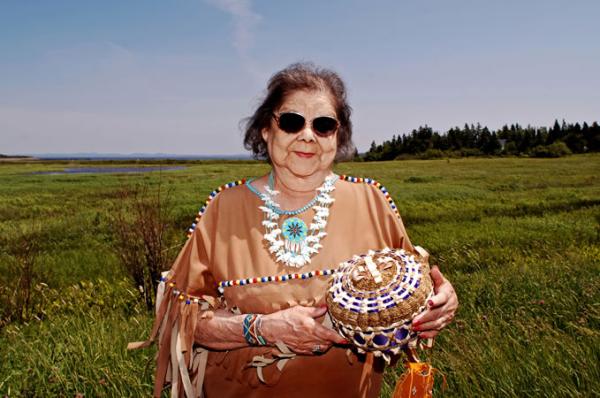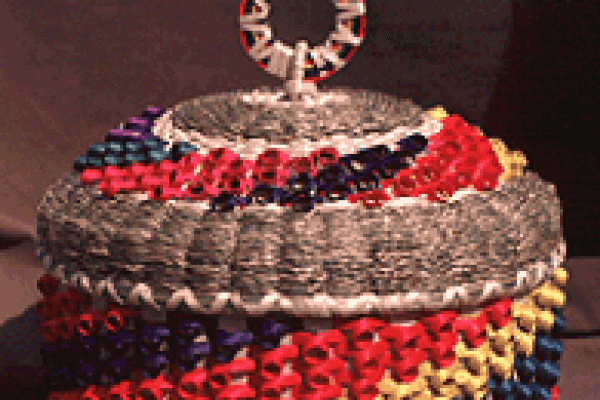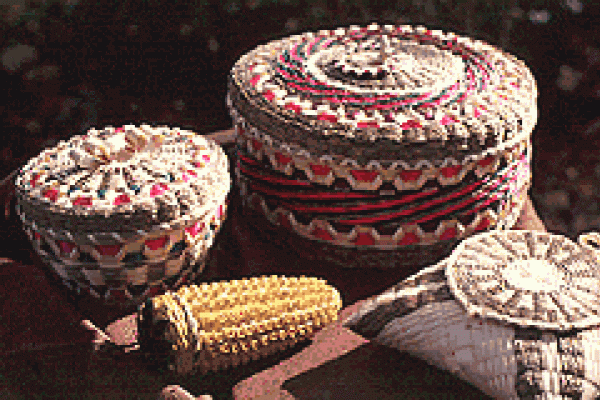Clara Neptune Keezer

Photo by Tom Pich
Bio
Clara Neptune Keezer was born on the Passamaquoddy tribal land of Pleasant Point (Sipayik) in Perry, Maine. The Neptune family was known for basketmaking and for leading the Passamaquoddy tribe for more than 200 uninterrupted years prior to her birth. Clara Neptune learned to make baskets from her grandmother and mother, weaving her first basket at the age of eight. She worked with the preferred materials of Maine basketweavers, split brown ash and sweetgrass, to fashion both utility and fancy baskets. Although basketweaving was experiencing a decline in Maine in the 1950s, Keezer became involved in the revitalization of the basketweaving tradition. Not content to replicate old forms exclusively, she began building on the tradition of the strawberry basket. Her baskets appeared in many touring exhibitions, including the influential Lost and Found Traditions: Native American Art 1965-85. Ralph T. Coe, curator of that exhibit, said "Clara Keezer is the finest splint craftswoman I met in the Northeast." Today, she continues basketweaving and teaching young people her skills. She has made innovations to the strawberry basket tradition, weaving a cornucopia of brightly colored vegetable and fruit baskets that have become popular among community members, as well as museums and basket collectors.
Interview with Mary K. Lee
NEA: I want to congratulate you on your award. What was your reaction was when you heard the news?
Keezer: Well, I was pleased. Happy.
NEA: Was it a surprise for you?
Keezer: It was, after four years of trying.
NEA: Can you tell me a little bit about how you learned to make your baskets and who you learned from?
Keezer: It was all around me growing up. I lived with my grandparents and I just liked what they were doing and I just picked it up. I guess that's how I started.
NEA: Who did they learn from?
Keezer: From their parents.
NEA: It sounds like it stretches back pretty far in the community.
Keezer: Yes, way back.

|

|
|
NEA: Do you remember the first basket that you ever made?
Keezer: I was eight years old and I was in Old Town with my grandmother, where she was from. We would go there for the summer sometime. I just wanted to make a little one. Usually there were tourists that came by and wanted to buy baskets. I had this little one almost finished. I made it on a jar, a mustard jar or a mayonnaise jar , I don't remember just what. But I made that and I finished it with the help of my grandmother. I sold it for fifty cents and I was proud.
NEA: The two types of basket making you do now are with brown ash and sweet grass. What are the differences in how you prepare the materials?
Keezer: There's a lot of work to prepare the ash. The men have to pound the ash to get the strips off. Then we have to split it and gauge it - scrape it and gauge it for the fancy baskets we want to make - and that's really hard work.
NEA: How long does it normally take to prepare the materials?
Keezer: We usually try to get everything done in one day. That way we can set it aside and get it whenever we need it.
NEA: I know the sweet grass is usually gathered up in July and August. With such a short harvest period for sweet grass, how do you keep those materials on hand throughout the year?
Keezer: Oh it keeps forever. My son picks the sweet grass and we clean it and put it in small bunches, hang it up to dry. After it's nice and dry we wrap it up and put it in a dark place, like a closet or under the bed. It will keep for a long time.
NEA: It sounds to me that your family is pretty involved in the process and they help you a lot with your baskets.
Keezer: I have two sons that make baskets and they know all about the preparation. They even help me prepare the ash now.
NEA: I read that you do a lot of teaching.
Keezer: Yes. I have two apprentices right now but we haven't started yet. There's too much going on right now, so I have to put it off a little bit longer.
NEA: What are some challenges your apprentices might have in trying to learn how to make the baskets? What's the most difficult part?
Keezer: Getting the material and preparing it. We haven't really started on that yet. I did teach one girl. I had her for two years and she really did good. But on her own, I don't know. She still might be able to do it right. They don't keep at it. Where I was growing up it was around me everyday. I guess they're trying to teach the children though the school. Some of these apprentices, they've graduated and they're trying to teach the young ones.
NEA: I read that your family revived the fruit-shaped baskets. Can you tell me about that?
Keezer: Some guy wanted a strawberry one made and the buyer asked me if I could make one. So I looked through some books. I knew what a strawberry looked like but I just wanted to get the shape of it right. I bought some plastic fruit and that's how I got started on the small berries, the strawberries, using the plastic fruit as a mold. Then I had a blueberry that was shaped like an orange. Blueberry, apple, plum and a corn basket. I worked on all them.
NEA: Did you find those difficult to do?
Keezer: The first one usually is difficult, then you get started and then it just comes natural.
NEA: Which baskets are the most difficult to make?
Keezer: The star basket. That's like a pillow, shaped like a pillow. You have to be real careful of the measurements. If you make one little mistake, it doesn't look right and it's very hard to take it apart.
NEA: I guess you've had star baskets that didn't come out right, especially in the beginning when you were learning.
Keezer: My grandmother's cousin lived next door and she showed me how to make the star basket. Of course it didn't turn out perfect right away, but with practice I was able to do it. She also showed me how to do the spiral weave and other baskets.
NEA: Did you know when you were young that you wanted to continue making baskets?
Keezer: I think so. I did get married and had five children and I didn't work too much while I was bringing up my children. But after they got to walking around and going to school, I went back to basket making again.
NEA: Does it matter to you whether your baskets are actually used?
Keezer: All of my baskets can be used. But I'm also glad that the museums and other collectors like to have some on display. But I'm really happy about whatever I can sell and when they tell me they like the work.
NEA: What about the designs for the baskets? Do you like to experiment and come up with your own designs?
Keezer: Yeah. I experiment, and my sister does too. She's a basket maker also. We like to experiment and put all different designs into one basket.
NEA: Were there other people in the community beside your grandmother and your mother who were making baskets and who you learned from?
Keezer: Almost everybody was making baskets back then.
NEA: What about now? Is there a lot basket making activity?
Keezer: There's not too many making baskets, except for the apprentices.
NEA: It seems like basket making is very connected to the community there. I was wondering if you knew why that might be, why it's seen as a valuable art form in that community?
Keezer: That could be now. When I was growing up it was just to make ends meet.
NEA: I know that you are a fluent speaker of the Passamaquoddy language and I was wondering if that's also something that you try to pass on to the next generation?
Keezer: They don't seem to want to learn. Even my own children don't speak the language. They understand it but they don't speak it.
NEA: What you're looking forward to the most abut going to DC?
Keezer: I'm going to be nervous.
NEA: Are you?
Keezer: I am right now. I'm going to Bangor tomorrow. They're going to honor me at the opening ceremony up there, at the Folk Festival. I'm rather nervous about that too. But I'm especially nervous about the one in Washington, next month. But I'll probably pull through it.

